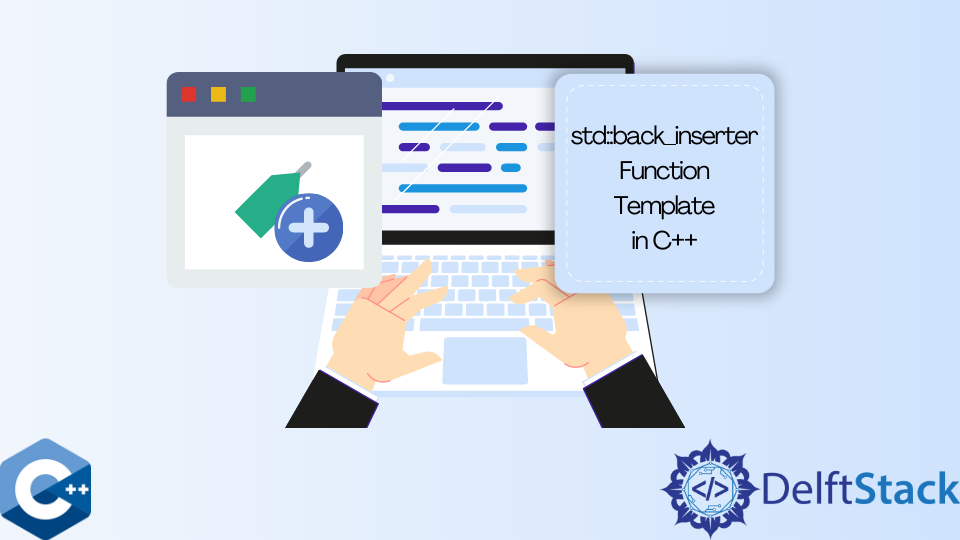C++ 中的 std::back_inserter 函式模板

本文將解釋如何在 C++ 中使用 std::back_inserter 函式模板。
使用 std::back_inserter 構造一個迭代器,在容器末尾追加元素
迭代器通常提供一個通用介面來訪問不同的容器型別。事實上,STL 演算法充分利用了這個介面。但是請注意,每個容器通常都會實現適合內部資料結構的自定義行為。
此外,我們有一個迭代器介面卡的概念,它在通用迭代器介面之上提供特殊功能。即,插入迭代器,它代表迭代器介面卡,用插入代替元素賦值操作,並讓 STL 演算法向給定的容器新增新元素而不是覆蓋它們。
存在三種預定義的插入迭代器:後插入器、前插入器和通用插入器。在這種情況下,我們演示了一個 back inserter 來在容器的末尾附加元素。請注意,後置插入器可以應用於具有 push_back 成員函式的容器。
以下示例程式碼顯示瞭如何使用 std::back_inserter 函式將 std::fill_n 演算法應用於 vector 容器,該函式會自動構造一個相應的後插入迭代器。
#include <iostream>
#include <vector>
#include <iterator>
using std::cout;
using std::cin;
using std::endl;
using std::vector;
template<typename T>
void printRange(std::vector<T> v) {
for (const auto &item : v) {
cout << item << "; ";
}
cout << endl;
}
int main() {
vector<int> v1 = {0, 1, 2, 3, 4, 5, 6, 7, 8, 9};
std::fill_n(std::back_inserter(v1), 2, 100);
cout << "v1: ";
printRange(v1);
return EXIT_SUCCESS;
}
輸出:
v1: 0; 1; 2; 3; 4; 5; 6; 7; 8; 9; 100; 100;
使用 std::back_inserter 和 std::set_intersection 演算法
或者,我們可以使用 std::back_inserter 和 std::set_intersection 演算法將兩個集合中的元素儲存到目標容器中,而無需提前保留大小。在下一個程式碼片段中,我們將該方法應用於 std::vector 容器。
#include <iostream>
#include <vector>
#include <iterator>
#include <algorithm>
using std::cout;
using std::cin;
using std::endl;
using std::vector;
template<typename T>
void printRange(std::vector<T> v) {
for (const auto &item : v) {
cout << item << "; ";
}
cout << endl;
}
int main() {
vector<int> v1 = {0, 1, 2, 3, 4, 5, 6, 7, 8, 9};
vector<int> v2 = {1, 2, 3, 4};
vector<int> v3;
std::set_intersection(v1.begin(), v1.end(),
v2.begin(), v2.end(), std::back_inserter(v3));
cout << "v3: ";
printRange(v3);
return EXIT_SUCCESS;
}
輸出:
v3: 1; 2; 3; 4;
此外,我們可以將 back_inserter 與 string 物件一起使用,因為後者實現了 STL 容器介面。因此,在 std::set_union 演算法的幫助下,我們可以將字串的部分附加到另一個字串物件。
#include <iostream>
#include <iterator>
#include <algorithm>
using std::cout;
using std::cin;
using std::endl;
using std::string;
int main() {
string s1("hello");
string s2("there");
string s3;
std::set_union(s1.begin(), s1.end(),
s2.begin(), s2.end(), std::back_inserter(s3));
cout << s3 << endl;
return EXIT_SUCCESS;
}
輸出:
hellothere
Founder of DelftStack.com. Jinku has worked in the robotics and automotive industries for over 8 years. He sharpened his coding skills when he needed to do the automatic testing, data collection from remote servers and report creation from the endurance test. He is from an electrical/electronics engineering background but has expanded his interest to embedded electronics, embedded programming and front-/back-end programming.
LinkedIn